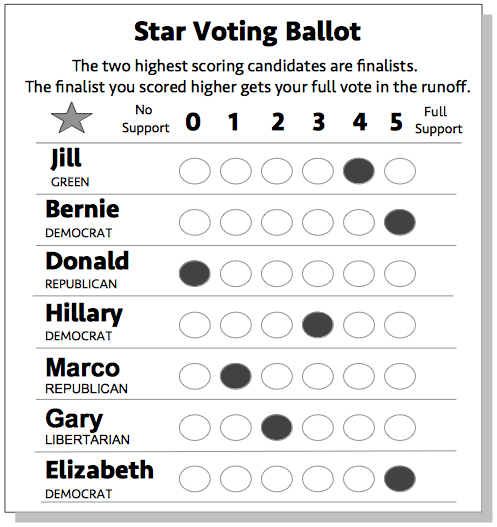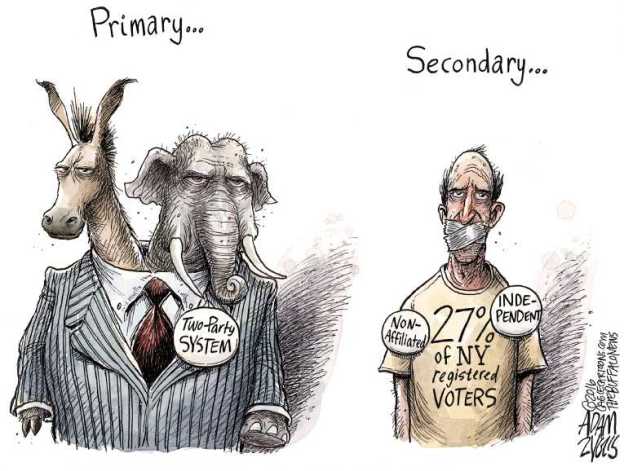Finally a way to vote your conscience and make every vote count.
Who? Everyone. Equally represented, equally included, and equally listened to.
What? It all starts with a new Unified Primary in early September but this is unlike any plan you’ve heard before. The top 5* candidates win and would all advance to the General Election. (*Or Top 6 or 7 or 8?) All candidates would run on one primary ballot together and voters would score the candidates they support with a new, more accurate system called Star Voting (aka. Score Runoff Voting or SRV.) You would give each candidate a score from 0-5. Star Voting allows you to honestly vote for multiple candidates and show varying degrees of support without having to worry about being strategic. The number of candidates each party is allowed to run in the Primary would be proportional based on party registration. Each party could run one candidate for each 5% or 10% of the electorate registered with them. Every party would be guaranteed at least one candidate. Additional candidates could petition to be added to the Primary ballot by gathering signatures. If a given race had less than the 5 candidates that race would skip the primary and the candidates would all automatically advance to the General Election. This really means that only the most important and hotly contested races even have a primary, so candidates running for most local offices wouldn’t have to spend so much time and money on campaigns trying to get elected to lower paying public service positions that only a few people want to do anyways.
Regardless of Political Party, the top 5* candidates (*or 6, 7 or 8) would go on to the General Election 2 months later in November. The top candidate from each party would be guaranteed a spot in the final round of debates up through November even if they didn’t qualify for the ballot. The General Election would be a straight forward Star Voting Election where voters score candidates from 0-5. The two candidates with the highest totals are finalists and the finalist preferred by the most voters wins.
So… if the primaries aren’t deciding the leader of each party how do political parties keep and develop their identities? Before the Unified Primary the political parties could still get together and hold conventions where the registered card holders participate. These conventions wouldn’t be primaries or caucuses. They would be for choosing who deserves a party endorsement and for choosing the party platforms. The parties still need a an opportunity to let their own members define what direction the party is going in and who should lead it! Political parties could endorse as many candidates as they want and they could also cross endorse candidates from other parties if they wanted. A candidate’s endorsements would be shown along with their party registration on the ballots.
Where? Everywhere! This would be an election system that scales well and would work for local, state or federal elections.
When? The Primary would take place 2 months before the general election. A shorter election cycle would save money and prevent candidate and voter burnout. Candidates should save some energy for actually doing their jobs once they are elected!
Why?
- Star Voting effectively ends the spoiler effect, wasted votes, and inaccurate, non-representative election results by letting voters express their full opinion and then taking all that data into account. All voters, candidates and parties should have an equal chance and an equal platform to be heard and listened to.
- This Star Voting+Unified Primary plan would save money and prevent burnout by shortening the election cycle. It would cut candidate fatigue in half while still giving voters a chance to narrow the field down to a number they can actually learn about and follow. This would help make running for office more accessible and affordable.
- Unified Primaries allow all voters to have a say in which candidates they would like to vote for, not just voters who perfectly walk a party line. The truth is that voters and candidates are individuals first and foremost. Some of us see eye to eye on many issues but the partisan primaries force candidates to pretend to perfectly fit a party line in order to win a partisan primary and have a shot at getting elected. Unified Primaries would allow candidates to create their own platforms and might even help the parties evolve to better represent the people over time. Lastly a Unified Primary helps ensure that candidates who have real support will make it to the general election. If people don’t have a voice in who can run in the general election then people really have no voice at all. In America many more voters identify as independent or non-affiliated than either Democrat or Republican and all voters deserve an equal voice.
- Your party registration would actually help your favorite political party but would never limit your options or your voice! Registration with a party you like would help that party increase their ballot access, but all parties would have some ballot access and full debate access anyways. Current party registration is not representative of actual voter affiliation because people currently have to register with the major parties to vote in the important primaries. If this problem was solved voters would be motivated to register honestly.
- For some people eliminating the primary altogether seems like a good idea. After all Star Voting is still accurate, even for elections with multiple candidates. Skipping a public primary would save a lot of public time, money and resources, but there would still need to be a way to decide who can run in the general election and who doesn’t make the cut. Eliminating public primaries would put the most important decisions in the election out of the hands of the people and into the hands of the party bosses to handle as they see fit. Most parties would chose closed private primaries that leave most voters and all independents excluded. We deserve better.
- Closed primaries are unfair and undemocratic. Equal but segregated was a popular pitch for decades but the truth is out. When you divide up services it’s just not fair or equal in practice. Keep the Primary unsegregated! A Unified Primary would give all parties an equal platform and equal opportunities to reach the voters!
How? All on one ballot measure baby! Or, if voters prefer an incremental approach we could pass Star Voting first in local non-partisan races and leave the rest of the system unchanged for now. Then we’d reform the primary in the following election.
So you might be thinking, “This all sounds amazing but what’s Star Voting and how does it work?”
Star Voting is an innovative new voting system designed by election reform advocate and Equal Vote founder Mark Frohnmayer with input and feedback from many of America’s leading election scientists. Until recently all the leading alternative voting systems fell short of the mark. Most were a huge step up from our current broken system and solved one problem or another but still were plagued by some major issues: Inaccurate or non-representative results, strategic and dishonest voting, vote splitting and the spoiler effect, complicated math, expensive and hard to implement logistics… the list goes on.
No voting system is perfect but Star Voting also known as Score Runoff Voting, does a really great job! You can and should vote your conscience. Every voter gets an equal vote and no party, voter, or candidate gets a special advantage. Star Voting is the most accurate system out there because it measures both the quality and the quantity of support that each candidate has overall. Star Voting is the reform we’ve been waiting for. It’s the reform we’ve desperately needed all this time.
Here’s how Star Voting works: You give each candidate a score from 0-5. Zero is “Worst” and Five is “Best” so you should always give your favorite a full score. Next you decide if you’d like to give some support to other candidates as well. It’s fine to give multiple candidates the same score but if you honestly prefer one to the other you scores should reflect that.
The ballots are tallied and the two candidates who scored the highest are finalists. The finalist that was preferred by the most voters wins the election.
In a multi winner election like the primary the ballots are tallied to find the first winner, then re-tallied to find the next winner and so on until all the seats have been filled or until the candidates have been sufficiently narrowed down.

Other Election Reforms to complete the picture.
The reform described above would lay the foundation for a real American democracy. This alone would accomplish more for voters than all the other reforms combined but there are a lot of other important building blocks that need to happen as well. We need to make election days legal holidays so that voters can take the time to research candidates and get their ballots in. We need to have at least a few in-person polling places to allow people who move during election season to still vote and to resolve issues with registration and messed up ballots. These polling places should offer same day voter registration! Most voting would still be Vote-By-Mail and places that don’t have Vote-By-Mail need to get on board with this fabulous, user-friendly system. Superdelegates should be outlawed. We definitely need to end corruption by passing much needed Campaign Finance Reforms. Campaign donations over $50 could be taxed and this money could be used to help fund our public election process. Corruption and buying off politicians needs to be illegal. Gerrymandering is easy to identify and fix by measuring “efficiency gap” and setting a limit on disparity of numbers of wasted votes between districts. Once we have fair districting we can improve proportional local representation and accountability. We need a system that triggers audits and recounts for close and contested elections in order to restore confidence that our election system isn’t being hacked or rigged. For Presidential Elections the winner of the National Popular Vote should win.
These election reforms are mostly easy sells to informed fair-minded voters. They are bipartisan issues that are just common sense. All we need in order to get major change is voters who care enough to get educated, get inspired, spread the word, and show up to vote!
This plan is a proposal from Sara Wolf to Equal Vote and RCV Oregon that can be used as a template for a statewide Oregon ballot measure to reform our elections.
To learn more and get involved:
Equal Vote
http://www.equal.vote
https://www.facebook.com/EqualVote/
Ranked Choice Voting Oregon:
facebook group: https://www.facebook.com/groups/1821618454770952/
facebook page: https://www.facebook.com/rcvoregon/

I don’t see why political parties still exist. The idea was for people with similar ideas to come together to promote their ideas. But the parties eventually morph into cults. I understand that the Founding Fathers didn’t want to have political parties, fearing that parties would spend more time opposing each other than governing.
LikeLiked by 1 person